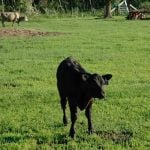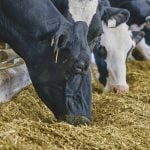Johne’s disease has no cure and causes production problems on three of every four Alberta dairy farms.
But researchers at the University of Calgary’s faculty of veterinary medicine say they’re making steady progress on a vaccine.
“Since there is no cure for it, all you can do is try to prevent your herd from getting the infection,” said bacteriologist and lead investigator Jeroen De Buck.
Even before a cow has what’s called “clinical infection,” its milk production can go down, along with its weight, he said.
Read Also

Solar and sheep provide valuable farm diversification
Agrivoltaics – the system of grazing sheep or conducting other agricultural activity under arrays of solar panels – can provide farmers with diversification options for their operations.
“It’s very hard to get rid of this disease once you have it on your farm because it is so insidious and stealthy,” he said.
Vaccines developed in the U.S., Europe and New Zealand prolong the period before animals become clinically infected, but don’t protect against new infections. None are registered for use in Canada.
De Buck’s team (which is being partially funded by the Alberta Livestock and Meat Agency and Alberta Milk) is in the initial stages of creating a vaccine to prevent infection.
But it will take a while before anything hits the market, he cautioned.
“It’s a fairly long process, and this disease is particularly difficult, because it is slow progressing,” he said.
Work on the vaccine began about six months ago, but research on various aspects of Johne’s disease has been underway for seven years.
From the Canadian Cattlemen website: Johne’s disease: Are we dong enough?
“Basically we want to create a vaccine that is a live strain, but attenuated, so it cannot cause the actual disease,” said De Buck.
An ideal vaccine, which could be used on very young animals, would generate protective immune responses in the vaccinated cow, so the infectious strain would not be able to take hold.
The first step is identifying genes essential for the organism to survive in the host and then removing them from the live strain of bacteria. That strain would be used to create a vaccine that would allow a cow to develop an immune response without the threat of infection.
The team also has to follow specific guidelines so their vaccine can be used.
“Current Johne’s vaccines strains interfere with the detection of tuberculosis in cows, which is a reportable disease,” said De Buck. “We need to make sure our vaccine doesn’t result in a positive test for Mycobacterium Bovis or MAP, so we’re marking our strain so people can tell that the animal was indeed vaccinated.”
Johne’ disease can affect cattle, sheep and goats and is caused by a bacteria called Mycobacterium Avium Subspecies Paratuberculosis (MAP). MAP is taken up by young animals through oral/fecal transmission and can lead to infection in the intestine.
Animals infected can be slow to gain weight and may develop diarrhea which can persist until death.
Producers can only prevent new infections by culling or segregating infected animals.
















